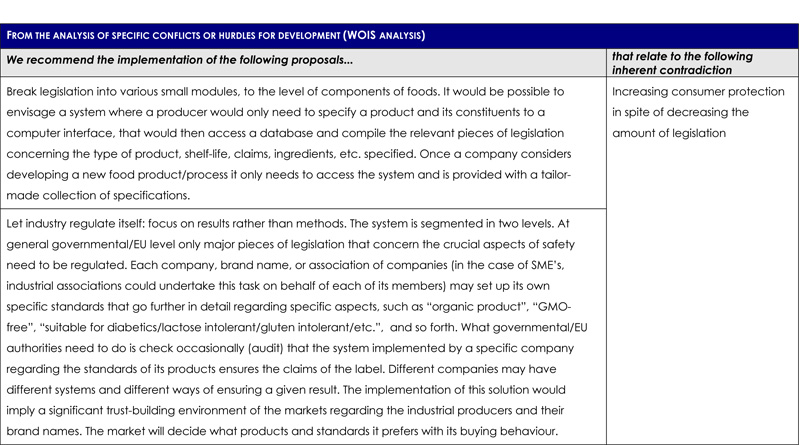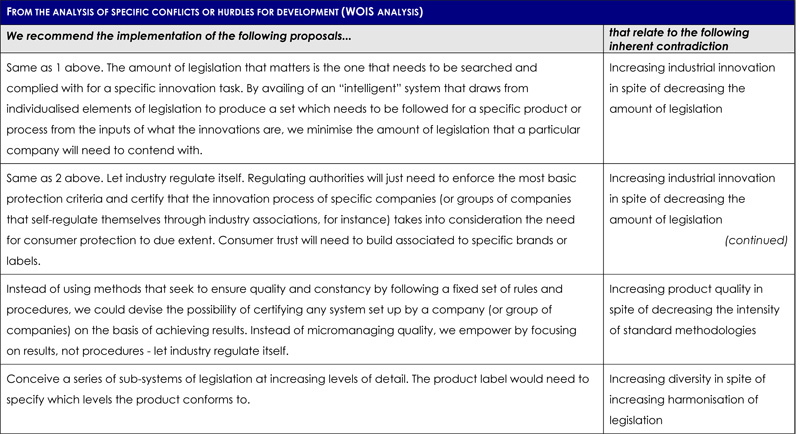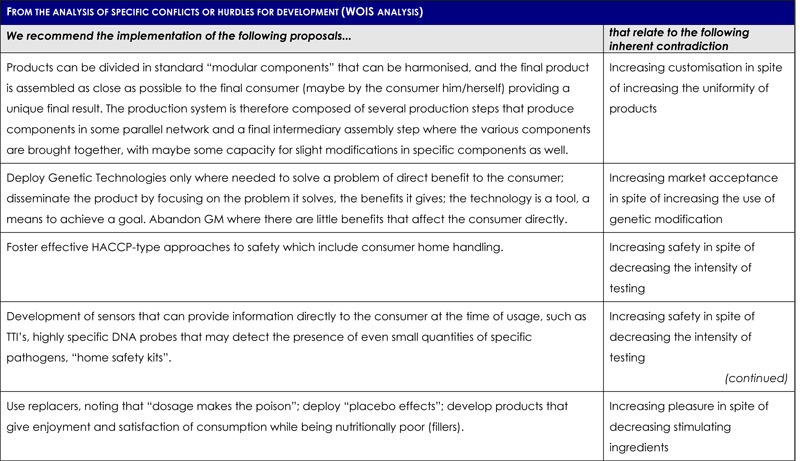Food Foresight: Analysis Of The Development Patterns Of The Food Industry And Markets Using TRIZ Concepts
Editor | On 25, Oct 2003
Food Foresight: Analysis of the development patterns of the Food Industry
and markets using TRIZ concepts
Jorge Oliveira, Dpt. Process Engineering, University College Cork, Ireland
Phone: 353-21-4902006
e-mail: j.oliveira@ucc.ie
webpage: http://www.ucc.ie/acad/departments/processeng/staff/oliveiraj.html
A small project termed Food Foresight was developed under the aegis of the European Union 5th Framework Programme, key action Food, Nutrition and Health, in 2002, and the final report has just been made available.
The work was developed in co-operation between University College Cork, Ireland (Dpt. Process Engineering), Wageningen University, Netherlands, and the WOIS Institute, Germany. The goal was to apply TRIZ concepts, and one of its related off-shoots, WOIS (Contradiction- Oriented Innovation Strategy, which uses TRIZ concepts and methods as part of its overall methodology), to develop a foresight exercise of the food industry and markets. This was a much wider and vague remit than technology forecasting in conventional TRIZ.
In order to achieve this objective, we performed a series of tasks:
· we started with a one-week workshop to train the work group in WOIS, and apply the concepts to the food markets. It was followed by a meeting with EU officials and experts of the food sector to collect inputs to the blueprint provided by WOIS;
· the work team split in two groups for missions to the USA and to Japan to interview experts, analyse case studies, and identify trends. These missions had the dual purpose of exploring TRIZ applications of interest, and analysing development patterns in food markets;
· Two types of analysis were then developed with the inputs gathered:
o A systematic analysis of what the abstract patterns of evolution imply regarding the development of the food industry, its challenges and opportunities;
o A focused selection of specific hurdles for the development of this industrial sector resulting from the WOIS work, followed by general ideas of possible solutions arising from the application of the TRIZ inventive principles.
The results were reviewed in a couple of meetings and the final report was produced. The report contains all details and is freely available for downloading in the Systematic Innovation webpage of University College Cork (http://www.ucc.ie/sysinov/ – follow links to Projects and Downloads). it is composed of the following elements:
· Main body of the report. Contains a summary of the work and provides a contextual discussion of predictions based on analysing patterns of development in industrial sectors in general. These lead to a series of proposals for the food industry which are then detailed. There is also a summary overview of the proposals that result from the more focused WOIS analysis of specific hurdles.
· Annex A. Contains a brief overview of TRIZ and WOIS from the perspective of application to foresight, folowed by a more detailed disucssion of the crucial hurdles selected and possible solutions. These address two major issues: (i) legislation and regulatory framework of the food industry; (ii) application of biotechnology to food processes.
· Annex B. Contains just a very brief overview of the inputs provided by the food industry experts fro Europe in the meeting that followed the first workshop.
· Annex C. Contains an account of the mission to the USA, with an overview of inputs provided in each visit/meeting, and a subsequent discussion. Some visits are particularly relevant regarding the development patterns that are emerging in the food sector, while others provide an insight into TRIZ applications.
It must be stressed that the purpose of this exercise is better served by stimulating responses and discussions, it is not intended to finalise the work with a bland and trivial set of proposals. Therefore the contextual discussions and visions may be controversial. They do not reflect personal or balanced opinions; they are the result of applying abstract development patterns. This technique may result in statements that can be challenged, like any prediction or speculation can anyway, but it has the benefit of providing a suitable ground for discussion and development of innovative proposals.
Results from analysing abstract patterns of development
From the identification and analysis of abstract patterns of development applied to food products and markets, we initially describe 4 major areas of development that we foresee as a result of the underpinning changes in society and enabling scientific and technological tools:
· product design engineering of foods – satisfaction of emotions and needs as the primary drive for product development.
· production on demand systems for foods – development of supply networks with multi-assembly production systems, delivering service at point of sale/consumption with tailor-making capacity. A sub-area is the development of streamlined “lean†manufacturing systems for cheap production of bulk commodities and intermediate products.
· the litigation society – implications of the litigation environment to food products.
· molecular nutrition – the underpinning knowledge of what foods should and should not contain for specific individuals at a specific time.
These four areas provide “visions†of future developments that breed proposals for strategic areas of development. One very important enabling factor in all of them is information: it will be by a greater use of information and knowledge processing that most of the changes envisaged will be enabled (no surprise, as TRIZ predicts that systems often evolve minimising resources and effort by making more use of information and knowledge). This then creates three additional areas of development that we need to consider:
· information and knowledge flow – systems that can acquire, search, retrieve and deliver specific knowledge at specific times and places.
· inexpensive sensors – micro- and nano-sensors integrated in higher level systems or stand-alone, with the ability to analyse individuals and/or food products and provide information required to obtain relevant knowledge.
· technical intelligence systems – knowledge management systems of scientific and technical information for acquiring, searching, retrieving and deploying scientific knowledge for problem solving in process and product development. A final eighth area of development comes from technological developments, specific of the agro-food industry.
Results from the WOIS application
The focused selection of hurdles to be addressed by applying inventive principles to the underlying contradiction (conflict) addressed a selection of problems extracted on the basis of the input from the Brussels meeting, grouped in two main areas:
· Legislation and regulatory framework
· Application and use of bioinnovations
Some of the proposals repeat concepts already identified in the analysis from abstract patterns of development, which is logical. The most controversial results are likely to be:
· Apply the principle “let industry regulate itself†– current legislative approaches tend to micromanage quality and safety with overdetailed requirements of how exactly they need to be assured in each and every company and process.
· Deploy genetic engineering only in applications where there is a direct benefit to the consumer him/herself, giving lower importance and visibility to those that have indirect benefits to the consumer (if any), such as environmental, quality constancy or productivity oriented.
Summary of conclusions
An overview of the main conclusions is provided in the next tables.









